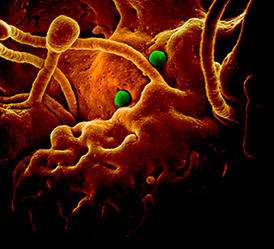Study Supports Camels as Primary Source of MERS-CoV Transmission
 National Institutes of Health (NIH) and Colorado State University (CSU) scientists have provided experimental evidence supporting dromedary camels as the primary reservoir, or carrier, of Middle East respiratory syndrome coronavirus (MERS-CoV). The study, designed by scientists from CSU and NIH’s National Institute of Allergy and Infectious Diseases, involved three healthy camels exposed through the eyes, nose and throat to MERS-CoV isolated from a patient. Each camel developed a mild upper respiratory tract infection consistent with what scientists have observed throughout the Middle East.
National Institutes of Health (NIH) and Colorado State University (CSU) scientists have provided experimental evidence supporting dromedary camels as the primary reservoir, or carrier, of Middle East respiratory syndrome coronavirus (MERS-CoV). The study, designed by scientists from CSU and NIH’s National Institute of Allergy and Infectious Diseases, involved three healthy camels exposed through the eyes, nose and throat to MERS-CoV isolated from a patient. Each camel developed a mild upper respiratory tract infection consistent with what scientists have observed throughout the Middle East.Samples taken from the camels showed high levels of infectious virus in secretions, primarily from the nose, for up to a week after infection; the scientists detected components of the virus for up to 35 days. Although the camels quickly recovered from infection without apparent complications, the researchers say the nasal secretions provide a likely source of transmission to people who handle the animals.
The researchers theorize that vaccinating camels could reduce the risk of MERS-CoV transmission to people and other camels; NIAID and others are supporting research to develop candidate vaccines for potential use in people and camels. The MERS outbreak, which began in 2012, continues throughout the Middle East. Since the outbreak began, NIAID researchers have focused on understanding how the virus causes disease and how it can be treated effectively. As of July 23, 2014, the World Health Organization has reported a total of 837 human cases of MERS-CoV infection, including at least 291 deaths.